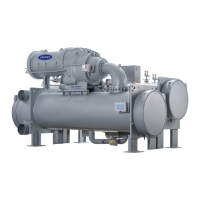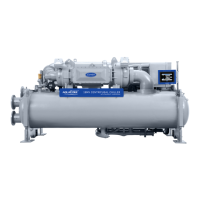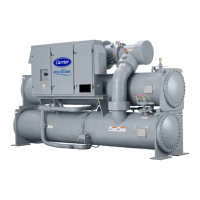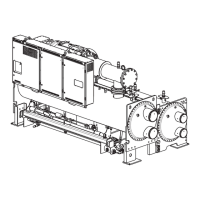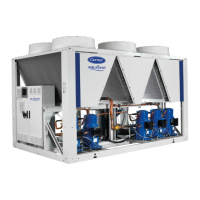83
COOLER-CONDENSER — Float chamber, relief valves,
refrigerant charging valve, temperature sensor locations,
pressure transducer locations, Schrader fittings, waterboxes
and tubes, and vents and drains.
OPTIONAL PUMPOUT STORAGE TANK AND PUMP-
OUT SYSTEM — Transfer valves and pumpout system,
refrigerant charging and pumpdown procedure, and relief
devices.
COMPRESSOR ASSEMBLY — Motor cooling system, oil
system, temperature and pressure sensors, sight glasses,
motor temperature sensors, synthetic oil, and compressor
serviceability.
COMPRESSOR LUBRICATION SYSTEM — Concen-
trator, oil pump, oil filter, oil heaters, oil charge and specifica-
tion, strainers, sight glasses, operating and shutdown oil level,
temperature and pressure sensors, and oil charging connec-
tions.
CONTROL SYSTEM — CCN and LOCAL start, reset,
menu, softkey functions, ICVC operation, occupancy schedule,
set points, safety controls, and auxiliary and optional controls.
AUXILIARY EQUIPMENT — Disconnects, separate elec-
trical sources, pumps, cooling tower, chilled liquid strainers,
and condenser liquid strainers.
DESCRIBE CHILLER CYCLES — Refrigerant, motor
cooling, lubrication, and oil reclaim.
REVIEW MAINTENANCE — Scheduled, routine, and
extended shutdowns, importance of a log sheet, importance of
liquid treatment and tube cleaning, and importance of main-
taining a leak-free chiller.
SAFETY DEVICES AND PROCEDURES — Electrical dis-
connects, relief device inspection, and handling refrigerant.
CHECK OPERATOR KNOWLEDGE — Start, stop, and
shutdown procedures, safety and operating controls, refrigerant
and oil charging, and job safety.
REVIEW THE START-UP, OPERATION AND MAINTE-
NANCE MANUAL
OPERATING INSTRUCTIONS
Operator Duties
1. Become familiar with the chiller and related equipment
before operating the chiller.
2. Prepare the system for start-up, start and stop the chiller,
and place the system in a shutdown condition.
3. Maintain a log of operating conditions and document any
abnormal readings.
4. Inspect the equipment, make routine adjustments, and
perform a Control Test. Maintain the proper oil and
refrigerant levels.
5. Protect the system from damage during shutdown
periods.
6. Maintain the set point, time schedules, and other PIC III
functions.
Prepare the Chiller for Start-Up — Follow the steps
described in the Initial Start-Up section, page 82.
To Start the Chiller
1. Start the liquid pumps, if they are not automatic.
2. On the ICVC default screen, press the or
softkey to start the system. If the chiller is in the
OCCUPIED mode and the start timers have expired, the
start sequence will start. Follow the procedure described
in the Start-Up/Shutdown/Recycle Sequence section,
page 60.
Check the Running System — After the compressor
starts, the operator should monitor the ICVC display and ob-
serve the parameters for normal operating conditions:
1. The oil sump temperature will vary from 50 F to 140 F
(10 C to 60 C) depending on the operating conditions. If
the chiller has not been running for a few hours the OIL
SUMP TEMP will be warmer than the CALC EVAP SAT
TEMP. When the chiller is not running, the oil heater is
energized whenever the OIL SUMP TEMP is less than
the smaller of 140 F (60 C) or 53 F (29.4 C) greater than
the CALC EVAP SAT TEMP. The OIL SUMP TEMP gen-
erally decreases slowly following start-up and eventually
stabilizes at a point lower than the temperature main-
tained during shutdown. The OIL PRESS DELTA P in-
creases above 18 psid (124 kPad) during start-up and gen-
erally does not vary by more than ± 2 psid (14 kPad). The
level in the oil sump is generally very stable. Changes in
the oil level occur very slowly.
2. When the compressor is running, the liquid level should
be visible in the oil sump or the strainer housing sight
glass. Low oil pressure alarms are imminent if the oil lev-
el drops below the bottom of the oil strainer housing sight
glass.
3. The OIL PRESSURE DELTA P displayed on the ICVC
default screen is equal to the difference between the oil
pressure leaving the oil filter and the oil sump pressure
transducer readings. Typically the reading will be
between 20 and 28 psid (138 and 193 kPad) after the oil
pressure ramp up is complete.
4. The moisture indicator (dry-eye) sight glass on the refrig-
erant motor cooling line should indicate refrigerant flow
and a dry condition.
5. The condenser pressure and temperature varies with the
chiller design conditions. Typically the pressure will
range between 60 and 135 psig (329 and 780 kPa) with a
corresponding temperature range of 60 to 105 F (15 to
41 C). The condenser entering liquid temperature may be
controlled below the specified design entering liquid
temperature to save on compressor kilowatt requirements
but, not be below 55 F (12.8 C).
6. Cooler pressure and temperature also will vary with the
design conditions. Typical pressure range will be between
30 and 40 psig (204 and 260 kPa) with temperature rang-
ing between 34 and 45 F (1 and 8 C).
7. The compressor may operate at full capacity for a short
time after the pulldown ramping has ended, even though
the building load is small. The active electrical demand
setting can be overridden to limit the compressor kW, or
the pulldown rate can be decreased to avoid a high
demand charge for the short period of high demand opera-
tion. Pulldown rate can be based on load rate or tempera-
ture rate by PULLDOWN RAMP TYPE in the
RAMP_DEM screen. AMPS OR KW RAMP%/MIN is ac-
cessed on the Equipment SERVICE screen, RAMP_DEM
table (Table 3, Example 28). TEMP PULLDOWN RAMP/
MIN is accessed on the TEMP_CTL screen.
To Stop the Chiller
1. The occupancy schedule starts and stops the chiller auto-
matically once the time schedule is configured.
CAUTION
Manuals and notebooks should not be stored under the
VFD power module, they will block air flow into the
power module cooling fan and cause the VFD to overheat.

